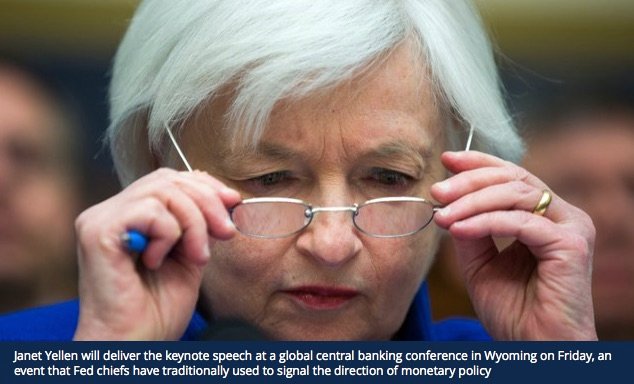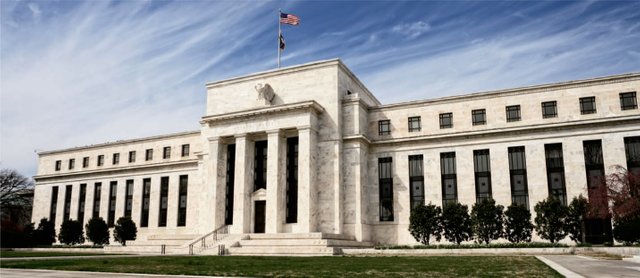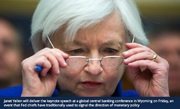Is the Federal Reserve System Broke?
This week the world’s Central Bankers are meeting in Jackson Hole, Wyoming. They will be pondering the world’s many contradictions and charting a path forward for monetary policy. At some point on Friday (26 Aug 2016), the top Banksters will emerge from behind closed doors, stand in front of the cameras reveal some version of reality as they would like us to see it. Many of uTs will wonder, “Do they have a clue at all what they are doing…?” Do THEY even know if the Fed is solvent or broke, and what does that even mean?

If you read to the end of this article, you will learn a secret that the banker’s will certainly NOT be telling in today’s press conferences…
Is the Fed broke? I use “broke” in the normal accounting sense of “insolvent” – i.e. liabilities in excess of assets, or negative net worth. This is the same situation that can drive an individual or a business into bankruptcy.
Superficially, the answer is “no”. The Fed publishes its financial statements on its website, and the balance sheet always shows assets in excess of liabilities, as one would expect. If they ever admitted otherwise, the Banksters would be exposed as frauds posing as monetary scientists.
I pulled the most recently published statements from the Fed’s website, dated 27 Jul 2016, and I learned that the Fed had assets totaling $4,464 billion and liabilities totaling $4,424 billion, leaving total capital of $40 billion to support the global dollar-based monetary system. That’s not a huge amount of capital, but I will admit that technically, the Fed is not “broke”, although it is leveraged 111x. This is a level at which no commercial bank would be allowed to operate or could operate.
The reason why no real bank could operate with such a slim capital base is that a very small decline in the value of the bank’s assets would wipe out the bank’s capital. Long before that day, however, the customers of any real bank (who presumable have a choice of where to put their money) would conclude that the bank was much too risky, and they would demand cash for their deposits, wiping out the bank’s liquidity and capital in the process.
High leverage amplifies the impact of price fluctuations in the central bank’s assets on the capital base. In the real world, it would only take a 1% decline in asset values to completely destroy the capital base and push the Fed into actual insolvency.
By what magic, then, is the Fed able to keep operating at such low levels of capital?
Three points:
First, FAITH… The system continues because people believe it will continue. This is a mysterious force that to the best of my knowledge can’t be explained through science, psychology or economic theory, and I will not attempt to do so. I’ll just leave it there. I suppose we can take some comfort in the fact that it has worked for 100+ years, even if the entire dollar system rests on a single point of failure – confidence. On the downside, many central banks in history with the ability to “print their way out of insolvency” have collapsed in other places and other times.
Secondly, the system survives because of the way the accounting rules are defined. Unlike other banks, the Fed is not required to “mark-to-market” the assets it holds. However, this does not negate the fact that these assets are extremely susceptible to price swings, and perhaps at no time more so than today, when interest rates are at 500-year lows. The majority of the Fed’s assets ($2,338 billion) are US Treasury notes and bonds, many of which were purchased in recent years through various programs of “quantitative easing” (QE). Included in this total is a large quantity of highly volatile 10-year notes purchased between 2010-2014 at yields of 1.5-2.5%. The market-to-market impact of a rise in rates can be estimated using conventional bond math, with the result that a market re-set of rates to even moderately higher levels would result in an insolvent Fed.
Third, the Fed has an ace up its sleeve – a secret asset hidden in plain sight. If a crisis in confidence undermines the “single point of failure” (FAITH) mentioned above, the ultimate confidence-building measure could be revealed. In his book “The New Case for Gold”, Jim Rickards discusses a seemingly minor asset buried in the balance sheet of the Fed called the “gold certificate account”. This is an $11 billion asset that arose from the Gold Reserve Act of 1934. When the Federal Reserve was formed in 1913, the private bank owners transferred gold to the regional reserve banks. This gold was eventually concentrated and combined with additional gold reserves resulting from the government’s confiscation of private gold in 1934. The owners of this gold, including the Fed, received gold certificates as “just compensation” when the gold was effectively seized by the Federal government and put in vaults in Ft. Knox (Kentucky), West Point (New York), Denver and a few other places.
The Fed’s gold certificate account was last marked to market in 1973 based on a gold price of $42.22/oz., representing about 261 million ounces, or approximately 8,000 tons of official US Treasury gold. At recent prices of $1,324/oz., this represents a hidden asset of $335 billion. At current value, this reduces the Fed’s balance sheet leverage from 111x to 12x, which is acceptable for a commercial banking operation.
Even if the Fed is insolvent based on its securities portfolio on a mark-to-market basis, it has never been insolvent taking into account the Fed’s hidden gold assets.

This is the secret Plan B that Janet Yellen and other central bankers will not be talking about after their meeting today in Jackson Hole. Confidence in the global monetary system rests on the dollar, and confidence in the dollar ultimately rests on 8,000 tons of official gold. As much as the money elites disparage the role of gold in public, it would be wise to observe their actions rather than their words. Governments and central banks are keeping gold in their vaults for a reason.
Does the Federal Reserve own or hold gold? (from the FAQ on the Fed’s website): https://www.federalreserve.gov/faqs/does-the-federal-reserve-own-or-hold-gold.htm
I would like to again recommend James Rickards book to anyone interested in this subject: “The New Case for Gold”. This post is largely based on the first chapter of his book, and anyone who finds this information interesting and useful should probably buy the book. It was published earlier this year and is available on Amazon and bookstores everywhere. I don’t take original credit for the ideas here. My intent is to summarize the arguments made by Rickards and others and point you to Jim’s book if you would like to explore the subject in more depth.
I would welcome a discussion in the comments with anyone who has an interest in the subject.

This post is here to inform your thinking, not lead it. Only you can decide the best place for your money, and any decision you make or don’t make involves risk.
If you like what you read here, don't forget to FOLLOW me so that future blog posts show up in your feed.


"assets totaling $4,424 billion and liabilities totaling $4,464 billion"?
To me that's a negative 40 billion of assets.
The fed will never go broke because the can create all the dollars they want.
What the consequences of that will be is anybody's guess.
Good catch. It's the other way around, and I fixed the typo. Assets $4,464B and liabilities $4,424B. Equity $40B and leverage of 111x. Your answer about creating as many dollars as they want is the standard answer, and they can do so. However, dollars (Federal Reserve Notes) are liabilities on the balance sheet of the Fed and do not solve a solvency problem at the Bank itself. It can (and has) "papered over" liquidity crises in the dollar-based global financial system. That's basically why the Fed balance sheet has exploded and become so over-leveraged since 2008.
Aa long as they can mark to fantasy their assets there ain't no problemo.
Great article. Was happy to share this on Twitter at stephenpkendal. Stephen.